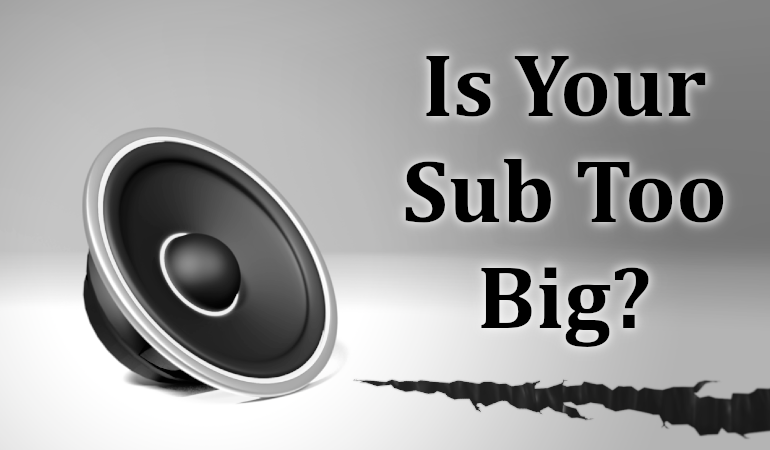Can A Subwoofer Be Too Big?
One of the most common questions I read is: Can a subwoofer be too big? If you have read any of my articles, you know what’s coming. It depends! The adage is that you can always turn a good subwoofer down. But what about one that is too large for your space? It’s not like you can make it smaller! Let’s discuss.
Subwoofer Truths and Myths
Ok, so let’s talk about the elephant in the room. Can a subwoofer be too big? Conventional wisdom would say no. For example, a small, underpowered, and underperforming subwoofer in medium (2500 sq feet) or large (2500+ sq feet) will sound terrible. Turning it up will cause it to overextend and chuff. It definitely won’t be impactful in the room. However, you can turn down a subwoofer that is too large for a room. So that makes sense. I had a single SVS PB1000 in a 2200 sq foot room. That sub’s size, extension, and output fit well within the guidelines for a medium-sized room. I quickly found out that those guidelines are quite generous! I never had the gain knob past 50%, and the sub sounded fantastic. So that seems to stick with the theory that a subwoofer can’t be too big for a room.
Myth 1 – Bigger Driver = More Sound
One of the most common myths is that a bigger subwoofer and driver equates to more sound. That isn’t the case in most home theaters. Yes, a larger subwoofer can be louder than a smaller one. But there is more at play than just the size of the actual subwoofer. How much amplification is behind it? What is the quality of the cone and surround? How much volume is in the cabinet? How well is the port tuned? How much bracing is in the enclosure? How powerful is the magnet? Bigger isn’t always better. I’d prefer a quality 10″ driver over a poor quality 15″!

Myth 2 – Bigger Box = Moar Headroom
Ok, so technically, this is not a myth. A larger subwoofer, with a larger amplifier, in a small/medium room will have more headroom. But guess what? A capable, smaller subwoofer can also have headroom. Not as much, but it can still play louder than you need (the definition of “headroom”). The question you need to ask is: will you ever use it? The answer is almost certainly no. As I have said, I had a single SVS PB1000 in a small to medium room and I never got past 50% gain. So it had a ton of headroom I will never use. So should I spend more to have even more headroom that I will never use? Absolutely not!

Myth 3.1 – A Bigger Subwoofer = More Explosive
One of the last myths that I want to address is a 2-for-1. I have read that a bigger subwoofer is more “explosive” than a smaller one. Unfortunately, these long-held myths refuse to die, no matter how much they get debunked. Explosiveness and speed have nothing to do with size. Instead, the quality of the cone, amplification, and design of the box matter. For example, my first subwoofer was a 12″ driver in a massive triple ported box with a 1000w amp on the back. It hit 25hz flat; that’s it! My little 10″ SVS has a 300w amp in a MUCH smaller cabinet and can hit 20hz flat all day, every day! And it hits like a sledgehammer.
Myth 3.2 – A Bigger Subwoofer = Slower
I also frequently read that a smaller sub is “faster” than a larger one. Pure BS! That is more about the quality of the recording or soundtrack than the subwoofer. I have played the same song on large/small(ish)/ported/sealed subwoofers, and they sound near identical. If the bass is mastered as a bloaty mess, it will playback as a bloaty mess. Same with movie LFE tracks. They will sound good on a quality subwoofer if they are mastered with good dynamics (I am looking at you, Thor: Ragnarok).

And remember, if you did your job correctly, you would have properly set up the subwoofer. Proper placement means that the subwoofer will blend in well with your speakers, and there will be no noticeable dips or nulls. However, if your bass is over-pronounced, it has nothing to do with the size or ports of the subwoofer; you have it set hot!
So Bigger Is Not Better?
You got it, Hoss! Say it with me, kids – bigger isn’t better. I know it’s hard. All that sexy marketing in forums and YouTube videos has brainwashed us!
First off, a single larger subwoofer may be able to have higher output in a room, but it doesn’t address room modes. Often we see bass that is not uniform across a room or is good only for a particular seat. This non-uniformity can create dips and nulls that can be very noticeable and impact the performance of your subs in the room.
Secondly, two smaller subwoofers are often easier to place in a room than a single, massive sub. My room is 13′ x 21′ and is multi-use. I have a bunch of physical media storage, a bar area, and other stuff in my man cave/home theater. So there is no way that I could fit a 15″ subwoofer in my room. My two 10″ subs are much easier to place. So I get the added benefit of better bass response, and I can tuck them out of the way in corners.
Lastly, a larger subwoofer can play havoc with your auto-on feature. It happens when you have either the gain or trim set too low on the subwoofer. The subwoofer will fail to pickup up the signal and turn it on. It rarely happens, and you can defeat it by leaving the sub “always on.” But, this is just an example of another reason that a bigger subwoofer is not always better.
Our Take
It’s easy to believe that bigger is better, especially in subwoofers. And let’s face it, it’s cool to have a massive subwoofer dominating your room! But that is not always practical, and in most cases, it’s wasteful. As much as we like to boast that we have tons of headroom or a bazillion watts of power, we will rarely, if ever, use it. It’s much better to mate the right subwoofer to your room or, better yet, a couple of suitable subwoofers.
What about your experiences? Do you have a massive subwoofer in your room? Were you pleased?


